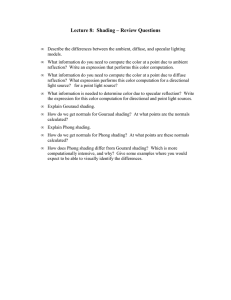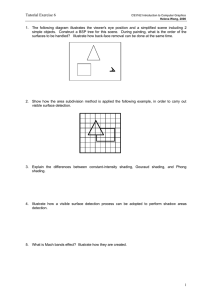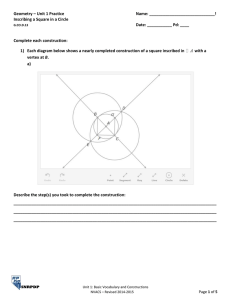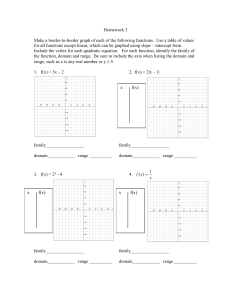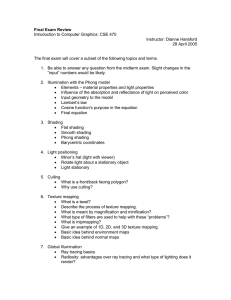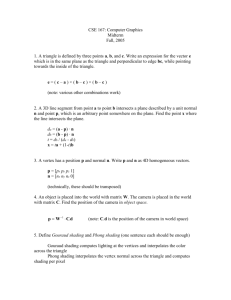Comp 410/510 Computer Graphics OpenGL Shading
advertisement
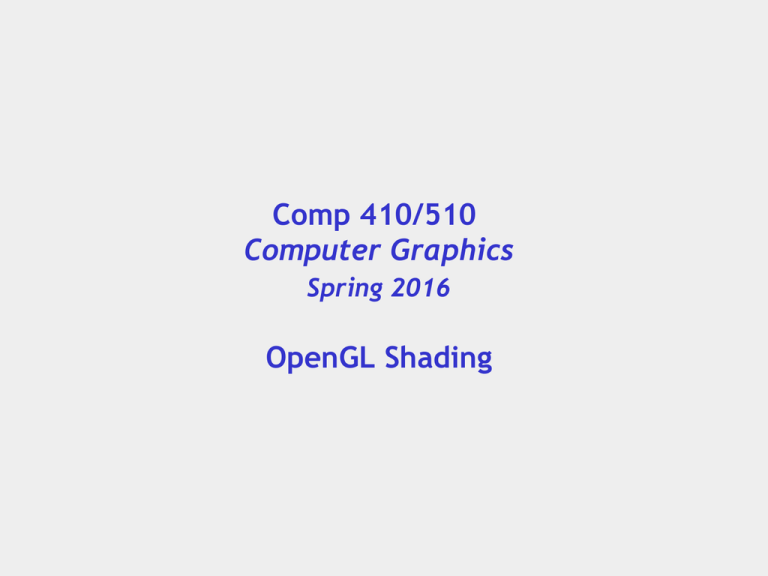
Comp 410/510
Computer Graphics
Spring 2016
OpenGL Shading
Objectives
• Introduce the OpenGL shading methods
­ per vertex vs per fragment shading
­ where to carry out
• Discuss polygonal shading
­ Flat
­ Smooth
­ Gouraud
OpenGL shading
• We need
• Normals
• Material properties
• Lights
• State-based shading functions have been deprecated (such as
glNormal, glMaterial, glLight)
• Compute them in application or send as attributes to shaders
Computation of Normal for Triangles
n
Plane equation:
Normal:
p2
n ·(p – p0 ) = 0
n = (p1 – p0 ) × (p2 – p0 )
Normalize by
n ← n / |n|
p
p0
Note that right-hand rule determines outward face
p1
Normalization
• Cosine terms in lighting calculations can be computed using dot
product
• Unit length vectors simplify calculation
• Usually we want to set the magnitudes to have unit length but
­ Length can be affected by transformations
­ Note that scaling does not preserve length
• GLSL has a normalization function
Defining a Point Light Source
• For each light source, we can set an RGB for the diffuse,
specular, and ambient parts, and the position
vec4
vec4
vec4
vec4
diffuse0[]={1.0, 0.0, 0.0, 1.0};
ambient0[]={1.0, 0.0, 0.0, 1.0};
specular0[]={1.0, 0.0, 0.0, 1.0};
light0_pos[]={1.0, 2.0, 3,0, 1.0};
I=
1
α )+ k L
(
k
L
l
·
n
+
k
L
(v
·
r
)
d
d
s
s
a a
a + bd + cd 2
Distance and Direction
• The source colors are specified in RGBA
• The position is given in homogeneous coordinates
­ If w = 1.0, we are specifying a finite location
­ If w = 0.0, we are specifying a parallel source with the given
direction vector
• In the distance term, d is the distance from the point being
rendered to the light source
I=
1
( kdLd l · n + ksLs (v · r )α )+ kaLa
2
a + bd + cd
Spotlights
• Can be implemented as a point light source with
­ Direction
­ Cutoff
­ Attenuation proportional to cosαφ
-θ
φ
θ
Global Ambient Light
• Ambient light depends on color of light sources
­ A red light in a white room will cause a red ambient term that
disappears when the light is turned off
• A global ambient term is often helpful, such as
vec4 global_ambient[] = { 0.2, 0.2, 0.2, 1.0 };
Since these numbers yield a small amount of white ambient light, even
if you don't add a specific light source to your scene, you can still see
the objects in the scene.
Moving Light Sources
• Light sources are geometric objects whose positions or directions are
affected by the model-view matrix
• Depending on where we place the position (direction) setting function,
we can
­
­
­
­
Move the light source(s) with the object(s)
Fix the object(s) and move the light source(s)
Fix the light source(s) and move the object(s)
Move the light source(s) and object(s) independently
Material Properties
• Material properties that match the terms in the Phong model:
vec4 ambient[] = {0.2, 0.2, 0.2, 1.0};
vec4 diffuse[] = {1.0, 0.8, 0.0, 1.0};
vec4 specular[] = {1.0, 1.0, 1.0, 1.0};
GLfloat shine = 100.0
I=
1
α )+ k L
(
k
L
l
·
n
+
k
L
(v
·
r
)
d
d
s
s
a a
a + bd + cd 2
Front and Back Faces
• Every triange has a front and a back face (specified by the order
vertices)
• For many objects, we never see the back face so we don’t care
how or if it’s rendered (normally both faces are rendered in the
same way)
• If it matters, we can handle in shader
­ Compute two different shades for each vertex in vertex shader, one
for front face and the other for back
­ Use boolean glFrontFacing to determine which one to use in
fragment shader
back faces not visible
back faces visible
Polygonal Shading
• In per vertex shading, shading calculations are done for each
vertex
­ Vertex colors become vertex shades and can be sent to the vertex
shader as a vertex attribute
­ Alternately, we can send the parameters to the vertex shader and
have it compute the shade
• By default, vertex shades are interpolated across an object if
passed to the fragment shader as a varying variable (smooth
shading)
• We can also use uniform variables to shade with a single shade
(flat shading)
Polygon Normals
• Polygons have a single normal
­ Shades at the vertices as computed by the Phong model appear almost the
same
­ Identical for a distant viewer or if there is no specular component
• Consider the model of a sphere
• May assign different normals at each vertex even though this
concept is not quite correct mathematically
Smooth Shading
• We can set a new normal at each
vertex
• Easy for sphere model
­ If centered at origin n = p
• Now smooth shading works
• Note silhouette edges
Mesh Shading
• The previous example is not general because we knew the
normal at each vertex analytically
• For polygonal models, Gouraud proposed to use the average of
normals around a mesh vertex
n1 + n2 + n3 + n4
n=
| n1 + n2 + n3 + n4 |
Gouraud vs Phong Shading
• Gouraud Shading
­ Find average normal at each vertex (vertex normals)
­ Apply (modified) Phong model at each vertex
­ Interpolate vertex shades across each polygon
• Phong shading
­ Find vertex normals
­ Interpolate vertex normals across polygons
- Apply modified Phong model at each fragment to find shades
Bilnear Interpolation (across a polygon)
Comparison (Gouraud vs Phong)
• If the polygon mesh approximates surfaces with high curvatures,
Phong shading may look smooth while Gouraud shading may
show edges
• Phong shading requires much more work than Gouraud shading
- Until recently not available in real time systems
- Now can be done using fragment shaders
• Both need data structures to represent meshes so that we can
obtain vertex normals
